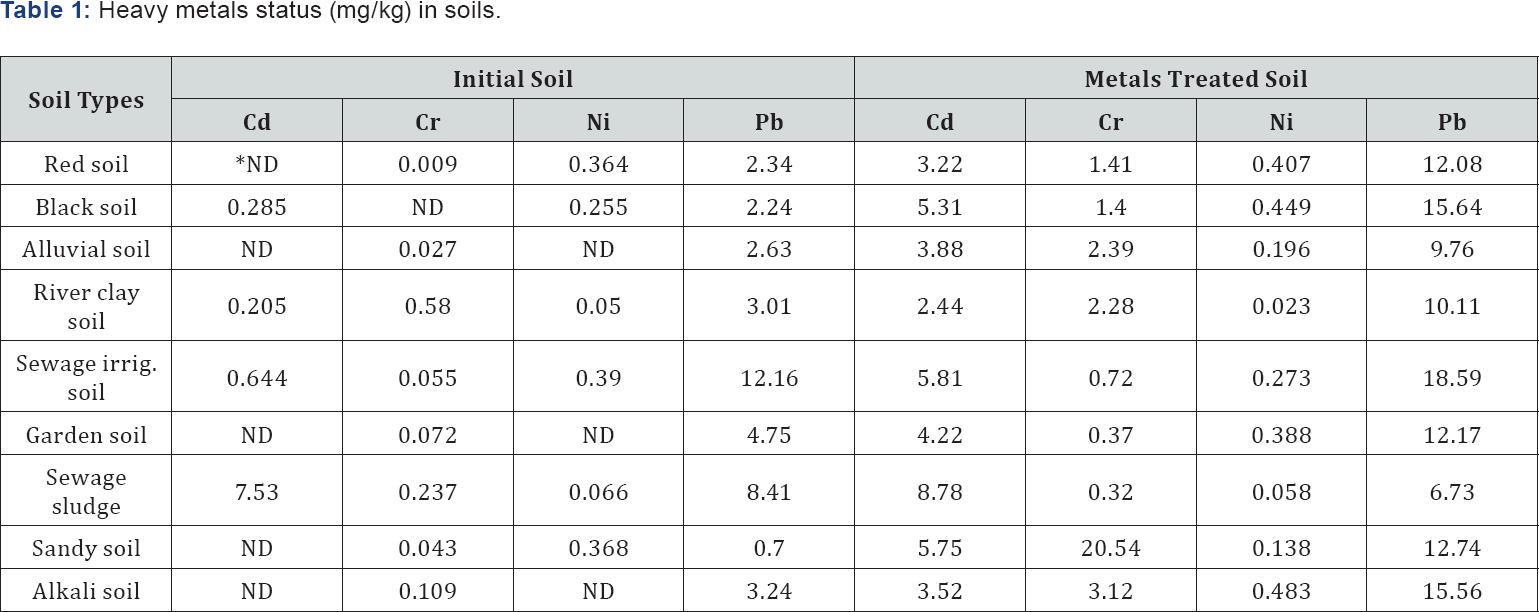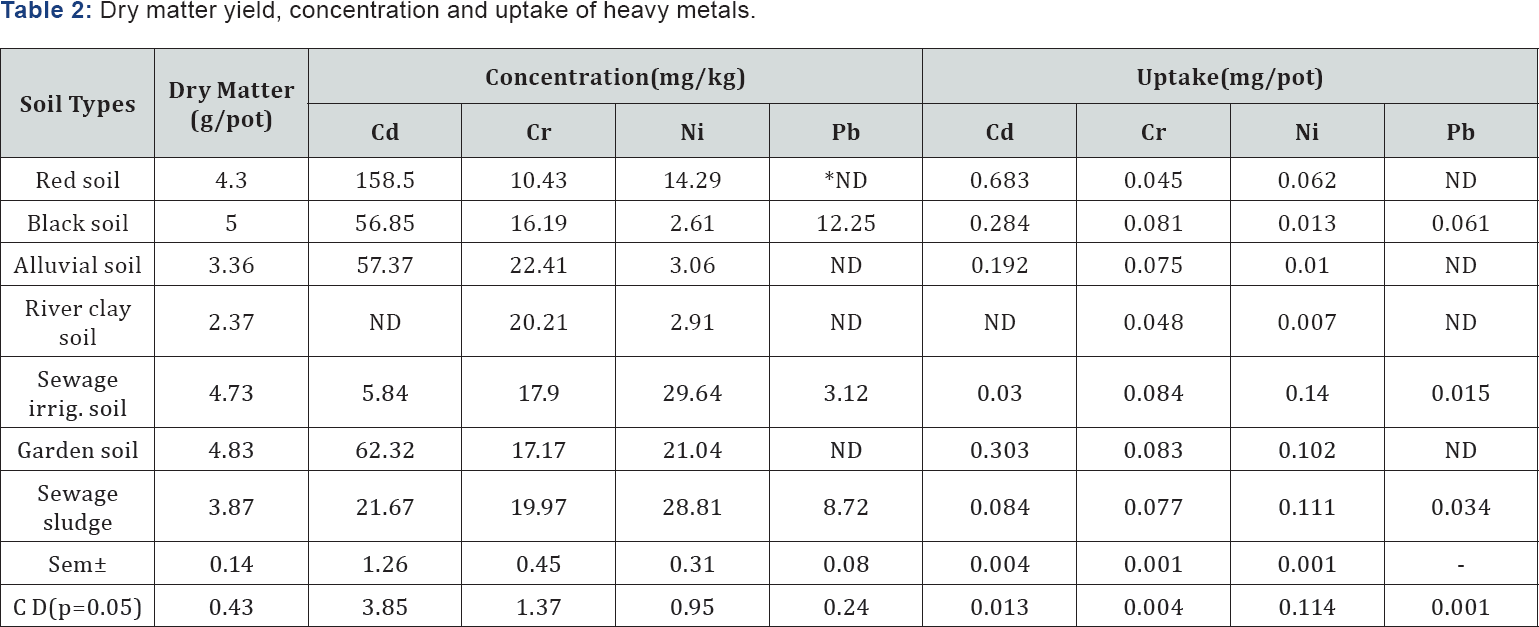Bioavailability of Heavy Metals (Cd, Cr, Ni, Pb) to French Marigold (Tagetes patula) in relation to Soil properties - Juniper Publishers
Journal of Trends in Technical and Scientific Research
Abstract
After one month of incubation of soils with Cd,Ni,Pb
and Cr at the rate of 5,10,20 and 30mg/kg, it was found that maximum
DTPA extractable concentration was 8.78mg/kg (Sewage sludge), 0.483mg/kg
(Alkali soil), 18.59mg/kg (Sewage irrigated soil) and 20.54mg/kg (Sandy
Soil), respectively. Coorelation study showed a highly positive
significant coorelation of Cd with organic carbon (r=0.883**), Pb with
clay (r=0.726*), Cr with sand (r=0.789*) and significant negative
coorelation of Ni with CaCO3 (r=0.813*). Marigold crop could
not survive in sandy soil and Alkali soil might be due to the Cr
toxicity and adverse physical condition, respectively. Highest uptake of
Cd was noticed in red soil while that of Cr and Ni is sewage irrigated
soil. Lead was less bio available. Concentration of Cr and Ni was
recorded in flowers where as Cd and Pb were not detectable. The pH had a
significant negative coorelation (r=-0.741*) with Cd uptake whereas a
significant positive coorelation of organic carbon(r=0.882**) was noted
with Cr uptake. It was further observed that dry matter yield had
positive coorelation with uptake and negative coorelation with content
of heavy metas in plants. The DTPA extractable Ni was almost not
detectable in post harvest soils.
Keywords:
Heavy metals; Contaminated soil; Phytoremediation; Bioavailability;
Alluvial soil; Alkali soil; River clay soil; Sandy soil; Black soil;
Garden soil; Sewage irrigated soil
Introduction
Heavy metals are among one of the pollutants which
pose severe threats to environment and their occurrence in soil
indicates the presence of natural or anthropogenic sources. Soil
physico-chemical properties are adversely affected by high concentration
of heavy metal, rendering contaminated soil unsuitable for crop
production [1,2].
The heavy metals may be transported through soil to reach ground waters
or may be taken up by plants .It has been observed that only a small
fraction of the total soil concentration of metals is potentially toxic [3].
This fraction is known as the mobile or bioavailable fraction which is
of concern due to its potential leaching in to ground water and/or
entering the food chain through plants [4].
Impact of heavy metals contamination on agricultural soils depends not
only on type and amount of contaminants but also on soil properties.
Variation in soil properties may significantly influence the
distribution as well as the bioavailability of heavy metals to plants [5].
Keeping the above facts in view, a study was initiated during 2008-09
to assess the impact of various soil properties on bioavailability of
heavy metals (Cd,Cr,Ni, Pb) taking French marigold as a test crop .
Methods
To conduct pot experiment, nine soils viz: Alluvial
soil Alkali soil, River clay soil, Sandy soil, Black soil, Garden soil
Sewage irrigated soil and Sewage sludge were collected from different
locations of Varanasi and Mirzapur districts .Soil properties indicated a
variation in pH 4.7 to 9.5, EC 0.10 to 2.59 dSm-1, OC 0.03 to 14.24%, CaCO3
0.5 to 10.5% and clay 8.79 to 44.56%. Pots lined with polythene sheet
were filled with 4kg of air dried soils. Soils in the pots were treated
with the dominant heavy metals present in sewage sludge such as Cd,Ni,Pb
and Cr at the rate of 5,10,20 and 30mg/kg, respectively. The soils were
irrigated to field capacity and kept in the net house for one month to
allow added metals to equilibrate before planting. Two plants of French
Marigold (Tagetes patula) Variety: Honey Comb was planted. Nine
soils were taken as treatments and replicated thrice in a Completely
Randomized Block Design. Fertilizer dose of N, P2O5, K2O
was applied at the rate of 100,45,45mg/kg soil. Plants were harvested
at flowering stage i.e. 90 days after transplanting. Plant samples were
washed sequentially with 0.2% soap solution, 0.1 N HCl and finally with
distilled water. Dried and ground plant samples were subjected for
analysis. Soil properties were analysed following standard analytical
procedures. Soils after one month of incubation were extracted by DTPA
as per procedure developed by Lindsay & Norvell [6]
and plant samples were digested in di acid. The content of Cd,Ni,Pb and
Cr in soil extract and plant digest was determined using atomic
absorption spectrophotometer (UNICAM-969).
Results
It is evident (Table 1)
that Cd,Cr,Ni and Pb concentration in metals treated soils after one
month of incubation ranged between 2.44 (river clay soil) to 8.78
(sewage sludge), 0.32 (sewage sludge) to 20.54 (sandy soil), 0.023
(river clay soil) to 0.483 (Alkali soil) and 6.73 (sewage sludge) to
18.59mg/ kg (sewage irrigated soil), respectively. Cadmium availability
showed positive and significant correlation with organic matter
(r=0.883**). It appears that organic matter likely to promote the
extractability of Cd in soil by supplying soluble organic complexing
agents which could reduce the Cd fixation in soil [2]. The Ni extractability in treated soils showed a significant negative correlation(r=0.813*) with CaCO3 which could be due to precipitation of CaCO3 that bind the Ni in unavailable fractions [7].

*Not Detectable
As regards to the heavy metals content in initial soil (Table 1),maximum
content of DTPA extractable Cd,Cr,Ni and Pb was noticed in Sewage
sludge (7.53mg/kg), River clay soil (0.58mg/ kg), Sandy soil
(0.36mg/kg), and sewage irrigated soil (12.16mg/kg), respectively. All
the heavy metals under study were present in sewage sludge and sewage
irrigated soils. Plant of marigold could not survive in Alkali soil due
to high pH and adverse physical condition and in Sandy soil because of
very high concentration of Cr (20.54mg/kg) recorded after treatment of
heavy metals which was used for growing crop.
The concentration of heavy metals in dry matter (Table 2)
indicates that maximum content of Cd,Cr,Ni and Pb was in Red soil
(158.58mg/kg), Alluvial soil (22.41mg/kg), Sewage irrigated soil
(29.64mg/kg), Black soil (12.25mg/ kg), respectively. Lead concentration
was not detectable in plants grown in Red soil, Alluvial soil, River
clay soil and Garden soil. The Cd concentration in plants showed
negative and significant correlation (r= -0.81*) with CaCO3
content of Dry matter yield, concentration and uptake of heavy
metals.soil. The concentration of Cr and Ni in flower ranged from 6.76
to 10.80 and 12.52 to 29.86mg/kg, respectively across the soils whereas
concentration of Cd and Pb in flowers was not detectable.
The uptake pattern of French marigold grown in different soils revealed (Table 2)
that maximum uptake of Cd,Cr,Ni and Pb was found in Red soil
(0.683mg/kg), Sewage irrigated soil (0.084mg/kg), Sewage irrigated soil
(0.14mg/kg) and Black soil (0.061mg/kg), respectively. A significant
negative correlation was recorded with soil pH (r=-0.741*) and CaCO3
(r=-0.804*) content of soil to that of uptake of Cd by plants whereas
highly significant positive correlation was noticed with Organic
carbon(r=0.882**) and Sand (r=0.783*) content of soil to that of Cr
uptake by plants. It has also been reported that Cd uptake had a
negative correlation with soil pH [8] and Cr uptake had a significant positive correlation with organic matter content of soil [9,10].

Plants grown in heavy metals treated soils showed
decline in growth and biomass yield as compared to control (untreated)
but Swage treated soil and River clay soil did not have any adverse
effect of heavy metals treatment on biomass yield. This may be due to
the fixation of heavy metals in these soils. The content of most of the
heavy metals showed negative relation with content and uptake of other
metals. It was noticed that with increase in dry matter yield, the
uptake of heavy metals by plants was found to increase but the
concentration of metals in plant decreased.
The DTPA extractable Ni content of post harvest soil
was not detectable except in Sewage irrigated soil (0.26mg/kg) and
Sewage sludge (0.45mg/kg).This might be due to high content of CaCO3
in these soils which precipitated and bound Ni in unavailable
fractions. A negative significant correlation (r= -0.813*) between CaCO3 and Ni availability of soil corroborate this result.
Conclusion
It is concluded that soil properties significantly
influence the distribution and bioavailability of heavy metals
(Cd,Cr,Ni,Pb) in soil and thus concept of bioavailability in determining
the critical content of heavy metals should be adopted for all soils.
To Know More About Trends in Technical and Scientific
Research Please click on:
https://juniperpublishers.com/ttsr/index.php
To Know More About Open Access Journals Please click on:
https://juniperpublishers.com/index.php
https://juniperpublishers.com/index.php




Comments
Post a Comment